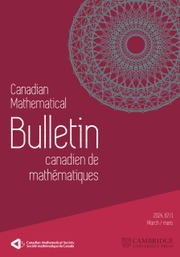No CrossRef data available.
Article contents
A free boundary problem of competition-diffusion system with Dirichlet boundary condition
Published online by Cambridge University Press: 07 July 2025
Abstract
In this article, we investigate a free boundary problem for the Lotka–Volterra model consisting of an invasive species with density u and a native species with density v in one dimension. We assume that v undergoes diffusion and growth in  $[0,+\infty )$, and u invades into the environment with spreading front
$[0,+\infty )$, and u invades into the environment with spreading front  $x=h(t)$ satisfying free boundary condition
$x=h(t)$ satisfying free boundary condition  $h'(t)=-u_x(t,h(t))-\alpha $ for some decay rate
$h'(t)=-u_x(t,h(t))-\alpha $ for some decay rate  $\alpha>0$, this is caused by the bad environment at the boundary. When u is an inferior competitor,
$\alpha>0$, this is caused by the bad environment at the boundary. When u is an inferior competitor,  $u(t,x)$ and
$u(t,x)$ and  $h(t)$ tend to 0 within a finite time, while another specie
$h(t)$ tend to 0 within a finite time, while another specie  $v(t,x)$ tends to a stationary
$v(t,x)$ tends to a stationary  $\Lambda (x)$ defined on the half-line. When u is a superior competitor, we have a trichotomy result: spreading of u and vanishing of v (i.e., as
$\Lambda (x)$ defined on the half-line. When u is a superior competitor, we have a trichotomy result: spreading of u and vanishing of v (i.e., as  $t \to +\infty $,
$t \to +\infty $,  $h(t)$ goes to
$h(t)$ goes to  $+\infty $ and
$+\infty $ and  $(u,v)\to (\Lambda ,0)$); the transition case (i.e., as
$(u,v)\to (\Lambda ,0)$); the transition case (i.e., as  $t \to +\infty $,
$t \to +\infty $,  $(u,v)\to (w_\alpha , \eta _\alpha )$,
$(u,v)\to (w_\alpha , \eta _\alpha )$,  $h(t)$ tends to a finite point); vanishing of u and spreading of v (i.e.,
$h(t)$ tends to a finite point); vanishing of u and spreading of v (i.e.,  $u(t,x)$ and
$u(t,x)$ and  $h(t)$ tends to 0 within a finite time,
$h(t)$ tends to 0 within a finite time,  $v(t,x)$ converges to
$v(t,x)$ converges to  $\Lambda (x)$). Additionally, we show that this trichotomy result depends on the initial data
$\Lambda (x)$). Additionally, we show that this trichotomy result depends on the initial data  $u(0,x)$.
$u(0,x)$.
MSC classification
Information
- Type
- Article
- Information
- Copyright
- © The Author(s), 2025. Published by Cambridge University Press on behalf of Canadian Mathematical Society


